Why microwave links are in the higher microwave spectrum (I don't know exactly but I guess it's around 20-40GHz). If by Friis Equation higher frequencies have lower range then why use higher frequency rather than low frequency?
-
Higher Frequency have higher bandwidth (how much data you can send per seconds). This is also why for instance WiFi new protocols goes from 2.4 to 5Ghz – Damien Sep 18 '18 at 03:49
-
How are bandwidth and frequency related? Is 1 Mhz equal to 1 Mbps? – ObsessionWithElectricity Sep 18 '18 at 03:56
-
See [Why is channel capacity a factor of bandwidth instead of frequency?](https://electronics.stackexchange.com/questions/86151/why-is-channel-capacity-a-factor-of-bandwidth-instead-of-frequency/86152#86152) – The Photon Sep 18 '18 at 04:03
-
But it's a lot easier to find a (for example) 10 MHz band of unused spectrum around 20 GHz than around 100 MHz. – The Photon Sep 18 '18 at 04:05
-
1@Damien you are mistaken. Higher frequency *does not* have higher bandwidth. Bandwidth is a *difference* between two frequencies. Some higher frequency bands may have larger *legal allocations* but that is a matter of law, not physics. However, a given bandwidth is a smaller proportional difference at a higher frequency, so it is easier to design wideband systems at higher center frequencies. – Chris Stratton Sep 18 '18 at 04:12
-
With 20 foot diameter parabolic dishes up on those old microwave relay powers, with wavelengths of 1cm (30Ghz) or 0.4 inches, the beam width would be 57.3 degrees / (a big number) or about 0.1 degrees. The towers were huge across the base, to be stable during windstorms, to ensure phone conversations continued. – analogsystemsrf Sep 18 '18 at 04:14
-
2@analogsystemrf what are talking about? – ObsessionWithElectricity Sep 18 '18 at 04:55
-
@ChrisStratton Modulation of the signal is limited by the frequency. Try to throughput 1Gbps of data on a 1Hz signal. Also at higher frequency you can have tighter channel and transmit in parallel in more bands. Some good info https://www.cisco.com/c/en/us/td/docs/solutions/Enterprise/Borderless_Networks/Unified_Access/CMX/CMX_RFOpFreqDataRates.pdf. Concerning bandwidth, it can be either a frequency range or data rate, I was referring to the second. – Damien Sep 18 '18 at 05:23
-
@Damien actually you *can* modulate a wideband signal on a low frequency carrier. In fact people routinely modulate signals on 0 Hz carriers. This is called "baseband" processing and it is how most modern radios work... (Doing it on 1 Hz instead of 0 would just be considered frequency error) Now, you can't *transmit* down there because physical properties would differ drastically and the low frequency components would not propagate at all. But the fact remains that bandwidth and center frequency are not really related in the way that you imply. – Chris Stratton Sep 18 '18 at 05:36
-
@ChrisStratton do you have reference to real world application of high dat arate transmitted on low frequencies ? – Damien Sep 18 '18 at 05:50
1 Answers
Microwave links require directionality or high gain antennas and they mainly use dishes (parabolic antennas) at each end. The high directionality means that a decent amount of the energy sent by the transmitter is picked up by the receiver. A higher operating frequency means more directionality for a given dish size: -
Notice the lambda term in the denominator; as frequency rises lambda falls and gain increases. The term D is the dish diameter. See this web page for more detail.
If by Friis Equation higher frequencies have lower range then why use higher frequency rather than low frequency?
First of all let's clear this misconception up; a transmitted radio wave has exactly the same "range" in free space irrespective of the frequency i.e. it reduces in power density as distance squares. But, of course, for a simple antenna such as a quarter wave monopole, its optimum length decreases with frequency hence the power it can extract from "the ether" also reduces. You have to start thinking about a receive antenna behaving like a fishing net. The wider the net, the more received energy (and fish) it can collect.
The Friis transmission equation has a lambda squared term in the numerator (causing link loss to increase with frequency) but, this effect is cancelled by the dish's lambda squared term in the denominator.
Friis link loss equation: -
- 434,556
- 28
- 351
- 777
-
So different kind of antennas behave differently to increase or decrease in f. But my question was that why do they use microwaves why can't they use radio waves with high gain antennas wouldn't they be better (face less attenuation)? – ObsessionWithElectricity Sep 18 '18 at 07:46
-
Secondly, Is it true that these waves not pass through walls of buildings? – ObsessionWithElectricity Sep 18 '18 at 07:47
-
An RF wave of (say) 100 MHz would need a parabolic dish the size of a house to get the same directionality as a regular sized dish at several GHz. Trying to make a high gain antenna at 100 MHz compete on performance with a dish at several GHz would mean higher cost and bigger size plus vulnerability in weather conditions. It's just not an economical option. Not sure about how deep they will penetrate - try googling. – Andy aka Sep 18 '18 at 08:29
-
Can I calculate dish size for a specific frequency. Can you link me calculator? – ObsessionWithElectricity Sep 18 '18 at 08:38
-
[Calculator](http://www.rfwireless-world.com/calculators/parabolic-dish-antenna-calculator.html). Enter frequency and diameter and press calculate. If you've finished with the previous question we talked at length about how about formally accepting it? – Andy aka Sep 18 '18 at 09:19
-
OK. I have accepted. Btw is the general distance between two microwave links very much so that such high gain is needed. Is it physical limitations or economical? – ObsessionWithElectricity Sep 18 '18 at 09:35
-
It is almost always ultimately a question of economics... High antenna gains are easy with reasonably sized antennas in the microwave bands (It is generating any real power at all to feed them that is a pain in the arse). While high gain low frequency antennas are physically possible, they become HUGE structures as the frequency falls. See for example the Duga radar system which was physically massive and operated at MHz to tens of MHz during the cold war. – Dan Mills Sep 18 '18 at 09:59
-
@ObsessionWithElectricity I was talking about your previous question "how can a phone transmit...." – Andy aka Sep 18 '18 at 10:05
-
These systems also require line of sight, don't they? In which case the curvature of the Earth starts to impose limits on range. – pjc50 Sep 18 '18 at 10:54
-
@pjc50 that's a good reason to put them on high masts apart from the problem of frying rabbits and ramblers LOL. – Andy aka Sep 18 '18 at 11:32
-
I didn't got your comment "these systems .... range". Also what is the exact frequency range. And can't they penetrate even one wall? How weak can the penetration is at these frequencies? – ObsessionWithElectricity Sep 18 '18 at 11:48
-
[searching for penetration depth using google help](https://www.google.com/search?q=microwave+radio+penetration+depth&safe=active&client=firefox-b&source=lnms&sa=X&ved=0ahUKEwjKw9Hgv8TdAhWCCOwKHQp3DwoQ_AUICSgA&biw=1182&bih=756&dpr=1) – Andy aka Sep 18 '18 at 11:59
-
@ObsessionWithElectricity "these systems" referring to microwave backhaul links for mobile phone base stations. I did a bit more research and it appears the "lower" (6GHz) bands can be used for non-line-of-sight. See https://www.tmcnet.com/tmc/whitepapers/documents/whitepapers/2014/10447-microwave-backhaul-lte-beyond.pdf which also quotes a maximum distance of 40km and higher frequencies of 60GHz. – pjc50 Sep 18 '18 at 14:19
-
@andy aka But isnt any frequency above 30Mhz already LoS . I think you mean to say that at such high frequency even a single wall would block the signal – ObsessionWithElectricity Sep 18 '18 at 17:46
-
But I haven’t made comments about a brick wall or LoS. Address them to the proper person and remember that this site isn’t a forum. – Andy aka Sep 18 '18 at 20:31
-
@Andy aka I asked the same question to you. I know you haven't talked about it . Can they not penetrate even one wall? – ObsessionWithElectricity Sep 19 '18 at 10:58
-
I do not know the precise answer - click on the links I and pjc50 left and do some research if nobody knows and I repeat I never said "at such high frequency even a single wall would block the signal" so please address that to the correct person because I don't know the precise answer. – Andy aka Sep 19 '18 at 11:36
-
Why so much gain is needed for the microwave backhaul.? Is it bcoz the distance is very large (for eg 50-60km) – ObsessionWithElectricity Sep 19 '18 at 12:44
-
Antenna gain is cheap up there, power is **expensive**, so you go with the antenna gain. Also, narrow directional links allow more frequency reuse because two links running between different towers can use the same frequency without interference, a thing not possible with low gain antennas that have poor pattern control. Line of sight is something of a simplification, but not that much of one, you can sometimes set up a grazing refraction from a ridge line or such but the mobile phone planners do not like relying on that sort of thing. – Dan Mills Sep 19 '18 at 13:09
-
High antenna gain = high antenna directionality hence safety and performance. – Andy aka Sep 19 '18 at 13:25
-
@Dan Mills Why is power expensive? Don't they use very small amounts around 30-40W? – ObsessionWithElectricity Sep 19 '18 at 19:29
-
30-40W for a microwave backhaul? Not bloody likely, generally less then a watt of transmitter output (often MUCH less then a watt), but at say 24GHz the dishes can have 30dB of gain each, so not much power is needed for any reasonable line of sight path. The expense comes from the fact that the semiconductors for high microwave are tricky, as is the design and materials selection to make anything useful up there. Fiberglass circuit boards for example are more or less useless above maybe 15GHz or so, which means that the cheap PCB tech that everyone uses at lower frequency is not an option. – Dan Mills Sep 19 '18 at 19:38

